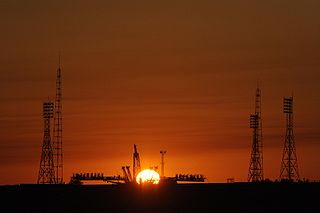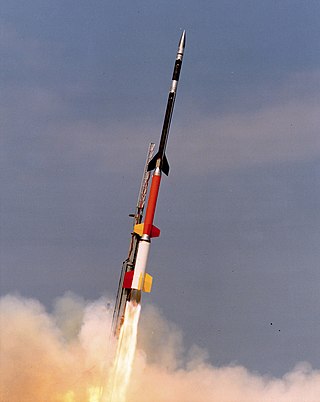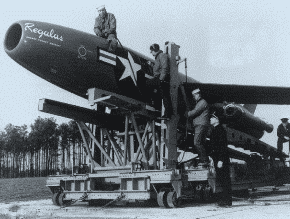
A rocket is a vehicle that uses jet propulsion to accelerate without using any surrounding air. A rocket engine produces thrust by reaction to exhaust expelled at high speed. Rocket engines work entirely from propellant carried within the vehicle; therefore a rocket can fly in the vacuum of space. Rockets work more efficiently in a vacuum and incur a loss of thrust due to the opposing pressure of the atmosphere.

A spaceport or cosmodrome is a site for launching or receiving spacecraft, by analogy to a seaport for ships or an airport for aircraft. The word spaceport, and even more so cosmodrome, has traditionally been used for sites capable of launching spacecraft into orbit around Earth or on interplanetary trajectories. However, rocket launch sites for purely sub-orbital flights are sometimes called spaceports, as in recent years new and proposed sites for suborbital human flights have been frequently referred to or named "spaceports". Space stations and proposed future bases on the Moon are sometimes called spaceports, in particular if intended as a base for further journeys.

Cuxhaven is a town and seat of the Cuxhaven district, in Lower Saxony, Germany. The town includes the northernmost point of Lower Saxony. It is situated on the shore of the North Sea at the mouth of the Elbe River. Cuxhaven has a footprint of 14 kilometres (east–west) by 7 km (4 mi) (north–south). Its town quarters Duhnen, Döse and Sahlenburg are especially popular vacation spots on the North Sea and home to about 52,000 residents.

A sounding rocket or rocketsonde, sometimes called a research rocket or a suborbital rocket, is an instrument-carrying rocket designed to take measurements and perform scientific experiments during its sub-orbital flight. The rockets are used to launch instruments from 48 to 145 km above the surface of the Earth, the altitude generally between weather balloons and satellites; the maximum altitude for balloons is about 40 km and the minimum for satellites is approximately 121 km. Certain sounding rockets have an apogee between 1,000 and 1,500 km, such as the Black Brant X and XII, which is the maximum apogee of their class. For certain purposes Sounding Rockets may be flown to altitudes as high as 3,000 kilometers to allow observing times of around 40 minutes to provide geophysical observations of the magnetosphere, ionosphere, thermosphere and mesosphere. Sounding rockets have been used for the examination of atmospheric nuclear tests by revealing the passage of the shock wave through the atmosphere. In more recent times Sounding Rockets have been used for other nuclear weapons research. Sounding rockets often use military surplus rocket motors. NASA routinely flies the Terrier Mk 70 boosted Improved Orion, lifting 270–450-kg (600–1,000-pound) payloads into the exoatmospheric region between 97 and 201 km.

Viking was a series of twelve sounding rockets designed and built by the Glenn L. Martin Company under the direction of the U.S. Naval Research Laboratory (NRL). Designed to supersede the German V-2 as a research vehicle, the Viking was the most advanced large, liquid-fueled rocket developed in the United States in the late 1940s, providing much engineering experience while returning valuable scientific data from the edge of space between 1949 and 1955. Viking 4, launched in 1950, was the first sounding rocket to be launched from the deck of a ship.
The Berthold Seliger Forschungs- und Entwicklungsgesellschaft mbH (BSFEGmbH) was a company founded by West German rocket technical designer Berthold Seliger in 1961. Seliger was a former assistant theoretician professor Dr. Eugen Sänger. The company developed and built prototypes of sounding rockets and launched them near Cuxhaven. The BSFEGmbH cooperated strongly with the Hermann-Oberth-Gesellschaft, of which Berthold Seliger was a member. The first rocket developed by the BSFEGmbH was an improved version of the Kumulus, which was first launched on 19 November 1962 and reached a height of 50 kilometres. On 7 February 1963 the BSFEGmbH launched a two-stage rocket with a maximum height of 80 kilometres and, on 2 May 1963, they launched a three-stage rocket with a maximum flight height of more than 100 kilometres. The latter rocket may have attained the highest flight altitude of all rockets built in post-war Germany. The signals from all these rockets were also received at the observatory in Bochum. After May 1963 the BSFEGmbH worked on the improvement of the steering system of their rockets and thought also on military usable rockets.
Kumulus is the name of a rocket of the "Hermann-Oberth-Gesellschaft e.V.". The first Kumulus rocket was launched on December 20, 1960, near Cuxhaven. A Kumulus rocket is on display at the Hermann Oberth Space Travel Museum in Feucht.
The Hermann Oberth Gesellschaft (1952-1993) was an association named after Hermann Oberth, the German astronautics pioneer and the authoritative expert on rocketry outside the United States, which develops and builds rockets and trains engineers in space technology.
Gerhard Zucker (1908–1985) was a German businessman and rocket engineer.

Operation Backfire was a military scientific operation of the Western Allies during and after the Second World War that was performed mainly by British personnel. The operation was designed to completely evaluate the entire V-2 rocket assembly, interrogate German personnel specialized in all phases of it, and then to test and launch missiles across the North Sea.

Arensch is a local part of Cuxhaven, a town in Lower Saxony, Germany.

Rocket mail is the delivery of mail by rocket or missile. The rocket lands by deploying an internal parachute upon arrival. It has been attempted by various organizations in many countries, with varying levels of success. It has never become widely seen as being a viable option for delivering mail, due to the cost of the schemes and numerous failures.
Seliger Rocket is the designation for the sounding rockets of the Berthold Seliger Forschungs- und Entwicklungsgesellschaft mbH. They were
- A single-stage rocket with a length of 3.4 metres and a takeoff thrust of 50 kN. This rocket was first launched on November 19, 1962, near Cuxhaven and reached a height of 40 km.
- A two-stage rocket with a length of 6 metres and a takeoff thrust of 50 kN. This rocket was first launched on February 7, 1963, and reached a height of 80 km.
- A three-stage rocket with a length of 12.8 metres, a diameter of 0.56 metres and a takeoff thrust of 50 kN. This rocket was first launched on May 2, 1963, with reduced fuel and reached an altitude of 120 km. Later with maximum fuel it reached a height of 150 km.
The Mohr Rocket was a sounding rocket developed by Ernst Mohr in Wuppertal, Germany.

Arcas was the designation of an American sounding rocket, developed by the Atlantic Research Corp., Alexandria, Va.
In Germany, military test rockets were launched in Peenemünde and Cuxhaven, and larger non-military rockets were launched in Hespenbusch, Cuxhaven and Zingst. In World War II, A4-rockets were also launched as weapons from several western areas of Germany. Several launchpads were also constructed for the Bachem Ba 349, developed in 1944/45.

The Civilian Space eXploration Team, also known as the CSXT, is a team of around 30 civilians interested in private spaceflight. The team was created by Ky Michaelson. Having conducted multiple rocket launches in an attempt to establish altitude records, CSXT became the first entity to officially launch an amateur rocket into space on May 17, 2004, with the successful launch of its GoFast rocket to an altitude of 116 km above the surface, which was verified by FAA analysis of the team's flight data.

Rohini is a series of sounding rockets developed by the Indian Space Research Organisation (ISRO) for meteorological and atmospheric study. These sounding rockets are capable of carrying payloads of 2 to 200 kilograms between altitudes of 100 to 500 kilometres. The ISRO currently uses RH-200, RH-300,Mk-II, RH-560 Mk-II and RH-560 Mk-III rockets, which are launched from the Thumba Equatorial Rocket Launching Station (TERLS) in Thumba and the Satish Dhawan Space Centre in Sriharikota.
The Lebanese space program was not initially an official government-sponsored effort. Rather, it revolved around the Lebanese Rocket Society which emerged from the Haigazian College Rocket Society, and was founded by Manoug Manougian in 1960. The original society gained fame in Lebanon after a series of successful launches of Cedar rockets and in 1962 President Fouad Chehab announced limited governmental funding for the renamed Lebanese Rocket Society which was also contacted by the Lebanese military to develop weapons.